When installing dry sprinkler systems, some extra effort, parts, and attention to detail are required
Proper installation is key to ensuring your fire sprinkler system functions properly when you need it most. But with additional control equipment and air pressurization devices not found in wet sprinkler systems, installing a dry sprinkler system ups the complexity factor.
In the first post in our series on dry pipe sprinkler systems, we explained what they are and their advantages and disadvantages over wet sprinkler systems. In this installment, we discuss some best practices, components, and NFPA requirements for installing dry sprinklers properly. Stay tuned for future blogs covering inspection, testing, and maintenance requirements, and special considerations for using dry systems.
Are you looking to buy components for your building’s sprinkler system? QRFS offers a range of dry sprinkler heads available on special order. Simply give us a call at 888.361.6662 or email support@qrfs.com.
You can also view our in-stock selection of sprinkler gauges, valves, supervisory switches, and other system components.
Dry pipe sprinklers: the best installation choice for specific scenarios
Property owners rely on dry systems for automatic fire protection in areas prone to freezing to mitigate the risks of leaky or burst pipes.
Here’s how they work: Instead of storing water, dry sprinkler pipes are filled with pressurized air or nitrogen that holds a main dry pipe valve in a closed position. The valve, set in a heated space, keeps the water supply from entering the pipes until a fire causes one or more sprinkler heads to activate. Once that happens, the air escapes and opens the valve, enabling water to flow through the open sprinklers onto the fire.
NFPA 13: Standard for the Installation of Sprinkler Systems sets strict guidelines for sprinkler system design approaches, system installation, and component options to prevent fire deaths and property loss.
Dry systems can be installed on their own or connected to other types of sprinkler systems. In fact, the NFPA minces no words in its recommendation to only install dry sprinklers on parts of a property where environmental circumstances make them the best solution. This is largely because the additional steps involved in triggering a dry sprinkler system create a delay of up to 60 seconds before the water reaches an activated sprinkler head, giving fires a little more time to spread.
From the 2022 Edition of NFPA 13
A.8.2 A dry pipe system should be installed only where heat is not adequate to prevent freezing of water in all parts of, or in sections of, the system. Dry pipe systems should be converted to wet pipe systems when they become unnecessary because adequate heat is provided. Sprinklers should not be shut off in cold weather. […]
Where adequate heat is present in sections of the dry pipe system, consideration should be given to dividing the system into a separate wet pipe system and dry pipe system. Minimized use of dry pipe systems is desirable where speed of operation is of particular concern.
Determining the water source for a dry sprinkler system
NFPA 13 requires every automatic sprinkler system to have at least one automatic water supply, and determining this is one of the first steps in any potential installation. Acceptable water supplies must provide sufficient flow for the required duration of sprinkler discharge. In many systems, this is determined by an occupancy hazard as outlined in table 19.2.3.1.2 and ranges from 30 to 120 minutes.
Many water supply sources contain sufficient volume but fail to offer sufficient pressure. The pressure needed typically ranges between 50 and 150 psi but largely depends on the layout of the sprinkler system.
Some of the water supplies NFPA 13 deems acceptable in section 5.2.1 require the addition of a pump to provide the needed pressure, including low-pressure municipal supplies, storage tanks located at or below grade, rivers, lakes, and reservoirs. Fire pumps can be used with other supplies like waterworks or gravity tanks to provide the pressure needed to meet system demand.
From the 2022 Edition of NFPA 13
5.2.1* Water supplies for sprinkler systems shall be one of the following or any combination:
(1) A connection to an approved public or private waterworks system in accordance with 5.2.2
(2) A connection including a fire pump in accordance with 5.2.3
(3) A connection to a water storage tank at grade or below grade installed in accordance with NFPA 22 and filled from an approved source
(4) A connection to a pressure tank in accordance with 5.2.4 and filled from an approved source
(5) A connection to a gravity tank in accordance with 5.2.5 and filled from an approved source
(6) A penstock, flume, river, lake, pond, or reservoir in accordance with 5.2.6
(7)* A source of recycled or reclaimed water where the building owner (or their agent) has analyzed the source of the water and the treatment process (if any) that the water undergoes before being made available to the sprinkler system and determined that any materials, chemicals, or contaminants in the water will not be detrimental to the components of the sprinkler system it comes in contact with
Determining the water supply and its pressure determines other necessary system components, such as a tank or pump.
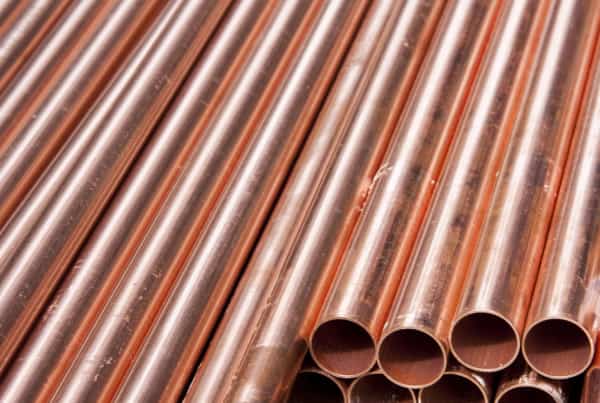
Pipe options for dry sprinkler systems
NFPA 13 permits several options for sprinkler piping in various types of systems (16.3), including copper, steel, and nonmetallic pipes. And many fire sprinkler systems are installed using either galvanized or black steel pipes.
But steel pipes tend to perform poorly in dry systems that rely on pressurized air instead of nitrogen. That’s because oxygen in the pressurized air tends to react with any pools of water trapped in the system and corrode the pipes — sometimes as quickly as two years after installation.
Copper tubing is a popular choice for dry systems because it doesn’t become as brittle at low temperatures and is less susceptible to corrosion. Chloro-polyvinyl chloride (CPVC) pipes, while a common choice for residential wet systems, are not safe for commercial dry systems. Not only can CPVC become brittle at low temperatures, but a serious safety hazard could occur if the energy of the pressurized gas is released suddenly due to a pipe rupture.
That said, Tyco has carried a UL-listed, CPVC-based dry pipe system that is listed for use in residential dry systems, making this an option for homeowners who may leave their homes without climate control for long periods of time.
Dry sprinkler heads 101 & avoiding trapped water in systems
More than 100 different types of dry sprinklers crowd the market, with standard lengths that vary in increments of ¼-inch or ½-inch up to the maximum listed length of 48 inches. Their temperature ratings typically range from 155°F to 286°F, and they come in a variety of finishes and configurations that meet NFPA 13 requirements. To avoid accidental discharge, it’s critical to install sprinklers with temperature ratings that match the maximum expected ceiling temperatures of the area being protected.
Dry sprinklers that are “listed” have been tested and certified to standards like UL 199, which evaluates such factors as physical strength, leakage resistance, sensitivity to environmental conditions, temperature rating, response time, water flow, and functionality.
Dry systems are typically installed with regular upright sprinklers or specifically listed dry sprinklers in freezing areas because these designs are less likely to trap water— a danger in cold environments where accumulated liquid could potentially freeze and lead to mechanical damage or sprinkler malfunctions. When it comes to residential sprinklers, 8.2.2.1 only allows sprinklers specifically listed for dry applications. There are also certain configurations and settings where non-dry pendents and sidewalls can be used:
From the 2022 Edition of NFPA 13
8.2.2.2 The following sprinkler orientations and arrangements shall be permitted for dry pipe systems:
(1) Upright sprinklers
(2)* Listed dry sprinklers
(3) Pendent sprinklers and sidewall sprinklers installed on return bends, where the sprinklers, return bend, and branch line piping are in an area maintained at or above 40°F (4°C)
(4) Horizontal sidewall sprinklers installed so that water is not trapped
(5) Pendent sprinklers and sidewall sprinklers, where the sprinklers and branch line piping are in an area maintained at or above 40°F (4°C), the water supply is potable, and the piping for the dry pipe system is copper or CPVC specifically listed for dry pipe applications
NFPA further mitigates the risk of trapped water by requiring installers to slope the piping in dry systems. While this is likely to increase labor costs, it facilitates drainage of any condensation that forms inside the pipe or water left over from valve trips or system inspection tests.
16.10.3.1 Dry Pipe Systems in Nonrefrigerated Areas. In dry pipe system, branch lines shall be pitched at least 1⁄2 in. per 10 ft (4 mm/m), and mains shall be pitched at least 1⁄4 in. per 10 ft (2 mm/m) in nonrefrigerated areas.
16.10.3.3. Dry Pipe and Preaction Systems in Refrigerated Areas. Branch lines shall be pitched at least 1⁄2 in. per 10 ft (4 mm/m), and mains shall be pitched at least 1⁄2 in. per 10 ft (4 mm/m) in refrigerated areas.
Managing cold conduction in dry sprinklers
The effectiveness of a dry sprinkler rests on its ability to manage cold conduction as temperatures slide from the freezing space to the water seal in the dry barrel. To make this work, a dry barrel inlet attaches to an extension nipple that connects to an approved sprinkler. The seal at the inlet end prevents water from entering the nipple until the sprinkler operates. Dry sprinklers also include a “weep” hole that allows for inspections to detect ice plugs, water leakage, or other build-ups that could cause damage.
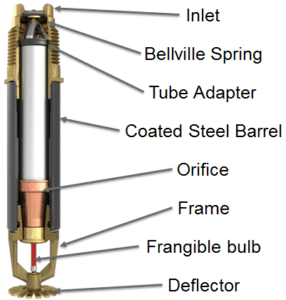
When dry sprinklers used in otherwise wet systems, NFPA 13 sets strict guidelines to ensure that installers expose enough of the dry barrel to the warmer ambient temperature in the heated space. This is done to prevent conduction along the barrel due to freezing, water-filled pipes.
From the 2022 Edition of NFPA 13
15.3.1* Where dry sprinklers are connected to wet pipe sprinkler systems protecting areas subject to freezing temperatures, the minimum exposed length of the barrel of the dry sprinkler shall be in accordance with Table 15.3.1(a) or Table 15.3.1(b).
15.3.2 The minimum exposed length shall be measured along the length of the dry sprinkler from the face of the fitting to which the dry sprinkler is installed to the inside surface of the insulation, wall, or ceiling leading to the cold space, whichever is closest to the fitting.
It’s worth noting that the values of exposed barrel length in the table below assume a properly sealed penetration and a maximum wind velocity on the exposed sprinkler of 30 mph. Where higher wind velocity is expected, longer exposed barrel lengths will help prevent the wet piping from freezing.
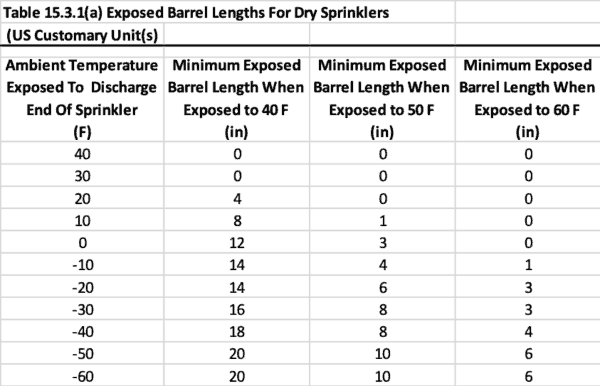
The inlet end of the dry sprinkler is installed into a threaded tee fitting, usually above a ceiling or enclosure. Installing dry sprinklers in 90-degree elbows or other couplings or fittings not specifically mentioned by the manufacturer could interfere with thread penetration or allow damaging condensation to accumulate above the seal.
15.3.4* Dry sprinklers shall only be installed in fittings as specified by the sprinkler manufacturer.
A.15.3.4 Generally dry sprinklers are installed in tees. Dry sprinklers should never be installed in 90-degree elbows. Some manufacturers allow installation of dry sprinklers in couplings, CPVC adapters, and so forth.
When dry sprinklers are connected to wet systems protecting insulated freezer structures, NFPA 13 also calls for the clearance space around the sprinkler barrel to be sealed. Otherwise, any warm, moist air that comes into contact with the dry, cold air inside the freezer is likely to cause condensation to form and freeze around the sprinkler frame — leading to obstructions or damage.
15.3.3* Where dry sprinklers are connected to wet pipe sprinkler systems protecting insulated freezer structures, the clearance space around the sprinkler barrel shall be sealed.
Dry pipe sprinkler system size matters for rapid water flow
NFPA 13 also regulates the size of a dry sprinkler system controlled by a dry valve. Section 8.2.3.4 caps the maximum capacity of an individual system at 750 gallons when quick-opening devices are present, and 8.2.3.3 caps it at 500 gallons when they are not. While this guidance leaves property owners with less flexibility to expand dry systems, it’s designed to ensure that flame-retarding water can reach a sprinkler head quickly once it’s activated by a fire.
The table below details the maximum water delivery time permitted by NFPA 13 between the time a sprinkler head opens and water is discharged. Calculations are based on the level of the hazard: for instance, “light” hazards may include offices or classrooms where ordinary combustible materials like wood or paper are typically present, while “extra” hazards are places like auto repair shops or aircraft hangars where fires tend to develop quickly with high rates of heat release.
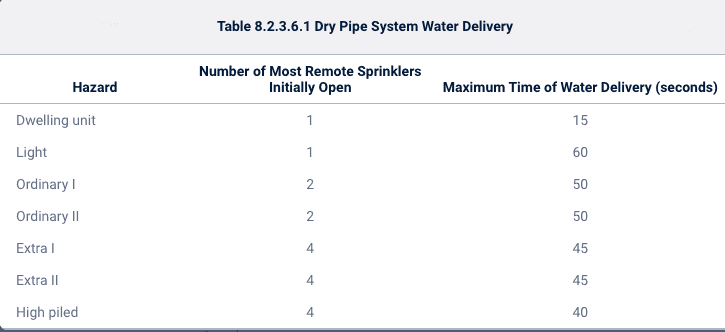
Note that section 8.2.3.8 also allows dry systems to have delivery times different than those specified requirements if they are “listed by a nationally recognized testing laboratory.”
Reliable automatic protection in freezing temperatures
There’s no denying that dry fire sprinkler systems are more complicated and expensive to install than wet systems. But in areas exposed to freezing temperatures, the upfront investment is worth the peace of mind they provide for reliable automatic fire protection.
Stay tuned for the next installments in our review of dry sprinkler systems and their applications, where we’ll explore more system components and inspection, testing, and maintenance requirements, including an in-depth look at how to prevent corrosion.
If you’re looking to buy components for your dry pipe sprinkler system, QRFS offers a range of dry sprinkler heads available on special order. Simply give us a call at 888.361.6662 or email support@qrfs.com and we’d be happy to help.
We also stock sprinkler gauges, valves, switches, and other parts that are applicable in dry systems.
This blog was originally posted at blog.QRFS.com. If this article helped you, check us out at Facebook.com/QuickResponseFireSupply or on Twitter @QuickResponseFS.


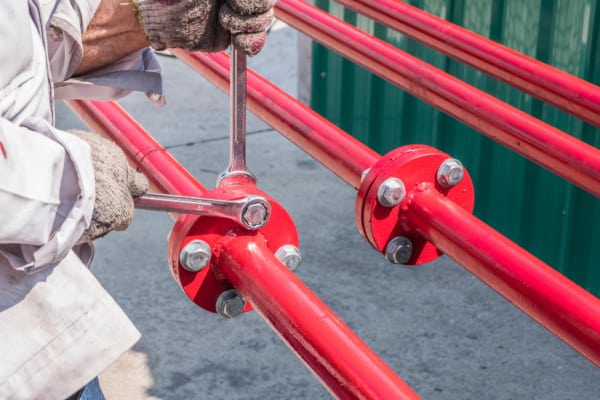
A question regarding dry pipe sprinkler systems – I understand the pendent should no be installed in 90 els. Does the same hold true for installation into tees – is it important as to installing the pendent into bowl of tee? If so , what is the reasoning behind it?
Thank you-
Timothy M Donovan
Timothy, thanks for reaching out. For code questions like this, we recommend submitting your question through QRFS Ask A Pro, qrfs.com/ask-a-pro. Click the link to submit your question with some information about your building or system, and a fire protection professional will provide a detailed answer based on standards and codes. Our pros include AHJs, contractors, engineers, and code experts with 150+ years of combined experience!
need dry sprinkler head for under canopy asap
Michael — Thank you for reaching out. We will have someone from our QRFS Customer Support Team contact you, and you can also email them any requests to get faster service!
Can a Dry sidewall be installed into a 2 1/2 x 1 Mechanical Tee?
Brian — The answer to that question specifically relies on the sprinkler and the manufacturer’s specifications. From NFPA 13:
15.3.4* Dry sprinklers shall only be installed in fittings as specified by the manufacturer.
A.15.3.4 Generally dry sprinklers are installed in tees. Dry sprinklers should never be installed in 90-degree elbows. Some manufacturers allow installation of dry sprinklers in couplings, CPVC adapters, and so forth.
do dry system compressors need generator back-up?
Gene — We aren’t aware of any specific generator requirements for dry system air compressors in NFPA 25 or NFPA 70. But you should verify/check with your local authority having jurisdiction and codes, plus insurance companies and policy providers may require them.
Hello,
must a dry sprinkler be fitted after the tee piece or is this also allowed with a flex hose
Kind regarts,
Thijmen
Thijmen — there are flexible sprinkler drops that can be used with dry systems. Here is a rundown on some of this equipment in Sprinkler Age. Thanks for the comment!
Is a specific air compressor required for a dry system?
Jon — We have a blog on air maintenance devices that may answer your question; you can check it out here. Thanks!
Is there any code prohibiting using dry sprinklers on a pre-action system where there is no probability of freezing temperatures?
Richard — We are not aware of anything in NFPA 13 that addresseses the scenario you describe, but you may want to run the scenario by contacting NFPA given the intent of the rules. The only explicit sprinkler-usage rules for preaction systems in section 8.3 are in the below section:
Thanks for reading.